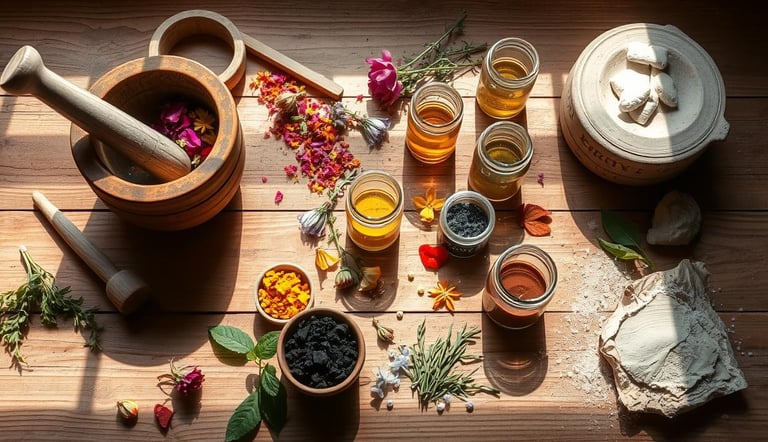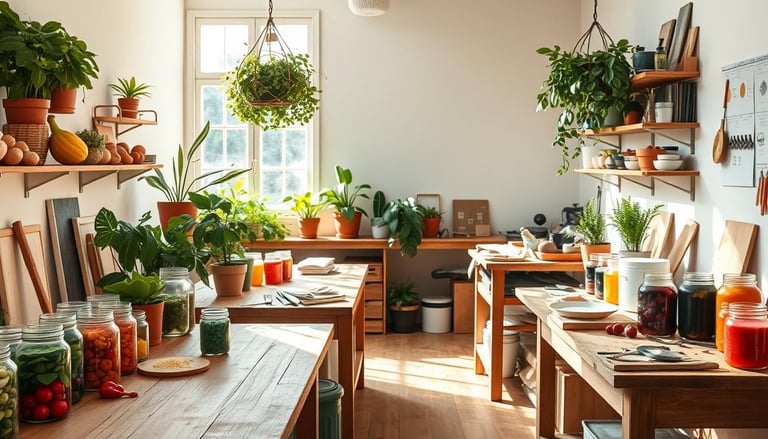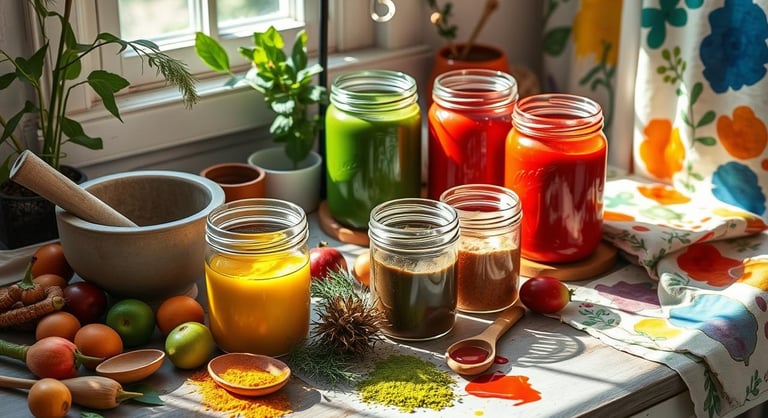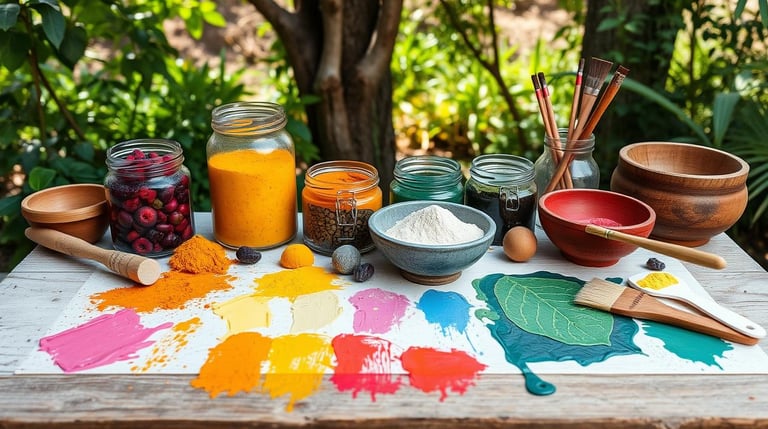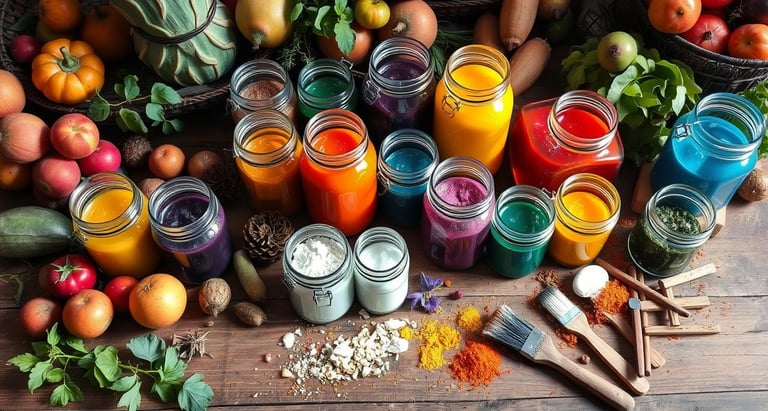Discover the Art of Natural Paint Making
Discover the joy of natural paint-making with my step-by-step guide. Learn how to create beautiful, eco-friendly paints using simple, natural ingredients.
PREPPING POSTS
Kathrine-Anne Hill
1/11/20259 min read
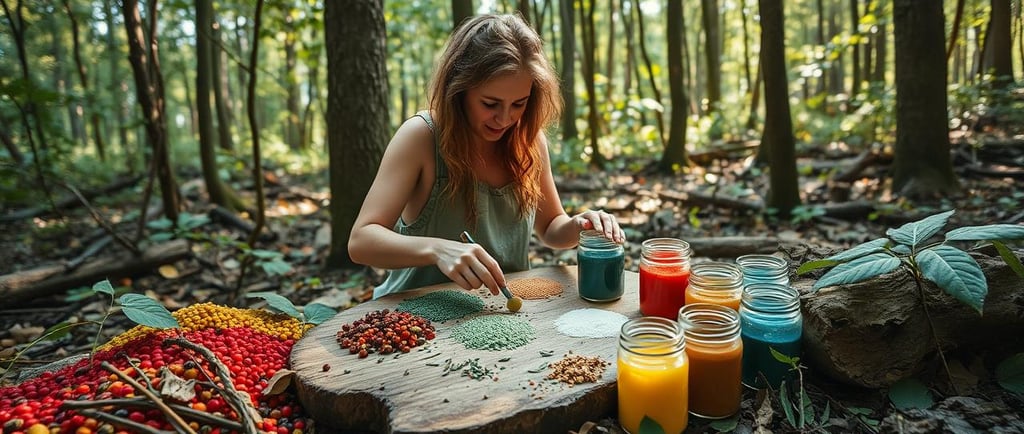

Discover the Art of Natural Paint Making: Your Guide to Eco-Friendly Colors
I'm excited to share the world of natural paint making with you. Here, we mix non-toxic paint making with eco-friendly recipes. We make natural pigments from things like rocks, soil, and plants. This helps reduce waste from plastic paint bottles1.
With natural paint, we can make beautiful colors using simple ingredients. I'm eager to explore the benefits of this green practice.
Learning about natural paint making is fascinating. We use safe and green ingredients to make our own paint. The global pigments market is big, valued at about $30 billion in 2020. It's growing fast, showing more people want eco-friendly colors2.
I'm excited to join this movement. I'm looking forward to sharing my journey with you.
Key Takeaways
Natural paint making is a sustainable practice that reduces environmental waste
Non-toxic paint making is a key benefit of natural paint creation
Eco-friendly paint recipes can be made using simple, natural ingredients
The global pigments market is growing, with a rising interest in eco-friendly pigment options2
Natural paint making can be a cost-effective alternative to purchasing mass-produced paints, with artists reporting a 30-40% reduction in art supply costs2
Handmade watercolor paints from foraged materials can match the quality of commercial watercolor paints in terms of lightfastness and stability for up to 90% of pigment types2
Understanding the Basics of Natural Paint Creation
Exploring natural paint making shows me the value of using eco-friendly ingredients. It's good for the planet and lets me express myself creatively3. Natural sources like black elderberries and wild mulberries can make different colors.
Using non-toxic ingredients is a big plus. It's better for us and the planet4. It also connects me with nature. For instance, turmeric can turn yellow to dark brown with berry juice3.
Red beets, purple berries, and green spinach are great for paint. They can make many colors. Mixing them with other ingredients lets me get the perfect shade and texture. This way, I make paints that are good for the earth and fun to make.
Red beets: can be used to create a range of colors from pink to deep red
Purple wild berries: can be used to create a range of colors from light purple to dark purple
Green spinach: can be used to create a range of colors from light green to dark green
These natural pigments can make many colors. Mixing them with other things lets me get the exact shade and texture I want4.
By using these natural pigments and eco-friendly ingredients, I make unique paints. They're good for the earth and let me express myself creatively3.
Essential Tools and Equipment for DIY Paint Making
To start making DIY paint, you need the right tools. For diy organic paint, you'll need a mortar and pestle, a sieve, and a mixing bowl5. These help mix and grind ingredients like berries and turmeric into powder. A glass muller, costing $50 to $90, is key for grinding pigments finely6.
A fine mesh sifter with 0.1 mm holes is good for refining pigments. The softness of pigment stones also matters5. Look for natural pigments in streams, rivers, and lakes. You can find colors like greens, oranges, and reds from local rocks5. When working with rock dust, wear an N95 respirator to avoid breathing problems6.
Here are some key tools and equipment you'll need to get started with DIY paint making:
Mortar and pestle
Sieve
Mixing bowl
Glass muller
Fine mesh sifter
N95 respirator
When making your own green paint formulation, try different ingredients and tools. This will help you get the color and texture you want.
Natural Paint Ingredients: From Earth to Palette
I'm excited to explore natural paint ingredients. We can get colors from the earth, like rocks and plants. Artists say using natural pigments connects them to the land7.
Mineral pigments give us earthy tones. Plant colors, like berries, add vibrancy. Making these pigments is key to eco-friendly painting7. Natural binders, like egg yolk, hold the colors together.
Mineral-Based Pigments
Mineral pigments create warm and cool tones. Ochre is golden, while umber is gray. Old masters used these to make balanced colors8.
Plant-Based Color Sources
Plant colors, like berries, add vibrancy. They can brighten a painting or create a unique palette. This is part of the "Slow Art Movement" for mindful art-making7.
Natural Binders and Their Properties
Natural binders, like egg yolk, hold pigments together. Their properties affect the painting's look and durability. This lets artists create unique, eco-friendly works.
Exploring natural paint ingredients lets artists create unique, eco-friendly works. These paintings show skill and creativity while promoting green painting7.
Safety Measures and Workspace Setup
When making non-toxic paint, safety is key. Make sure your workspace has good air flow. This stops harmful fumes from building up9. Good air flow also lowers the chance of fires10.
A clean, well-ventilated area keeps you safe from toxic stuff. This lowers the risk of breathing problems and other health issues9. Wearing protective gear like gloves and goggles also helps. It keeps you safe from paint dangers10.
To make your workspace safe, follow these steps:
Open windows or use a fan for air flow9.
Wear gloves and goggles for protection10.
Keep your area tidy to avoid accidents10.
By taking these steps, you can safely make non-toxic paint. This way, you can enjoy making eco-friendly paint without worrying about risks910.
Step-by-Step Natural Paint Making Process
To make your own homemade natural paint, mix sustainable paint ingredients like berries, spinach, and turmeric. First, simmer the plant materials until they get thick. How long it takes depends on the material11.
Keep at least 1 inch of water over the plant material while simmering11. This helps get the best color out of the plants.
A simple recipe for natural paint is 1 part egg yolk to 1 part water. Add a drop of vinegar to make it last longer12. Using eggs from free-range chickens makes the paint even better12.
Crush soft stones from Southern Virginia into pigment for painting. This shows you can find natural pigments close to home12.
Here are the steps to make your own homemade natural paint:
Simmer plant materials to get a thick consistency
Mix the dye with a binding agent, like egg yolk or oil
Add a drop of vinegar to make the paint last longer
By following these steps, you can make your own homemade natural paint. Use sustainable paint ingredients for eco-friendly art supplies11.
Creating Different Types of Eco-Friendly Paints
I'm excited to explore eco-friendly paint recipes. We can make many types of natural paints. This includes milk paint and earth pigment mixtures. With diy organic paint, we can try different ingredients for unique colors and textures.
Natural ingredients are key in eco-friendly paint recipes. Earth pigments give us earthy tones like red, yellow, and green13. Plant-based paints make vibrant colors like blue and purple13. These ingredients are good for the planet and add beauty to our art.
There are many types of eco-friendly paints we can make. Some favorites include:
Milk paint, made by mixing milk protein with natural pigments13
Earth pigment mixtures for earthy tones13
Plant-based paint recipes for bright colors13
By trying these paints, we can make unique and green art. This art shows our style and helps the planet. Eco-friendly paint recipes and diy organic paint open up a world of creativity13.
Troubleshooting Common Natural Paint Issues
Working with natural paint can sometimes lead to issues like uneven color or texture. Understanding the causes and using chemical-free paint mixing techniques can help. For example, bad weather can cause paint to not stick well14. Also, applying a hard coat over a soft one can make the paint lose its stretchiness due to temperature changes14.
Other problems include blistering, which happens when oil paint is put on a wet surface14. Chalking, or flaking, can happen with low-quality paints14. To fix these, use eco-conscious painting techniques like preparing the surface right and painting when the weather is good. Here are some common issues with natural paint:
Blistering: often caused by heat and moisture exposure15
Chalking: tends to occur in arid climates and is often linked to using low-quality exterior paints15
Cracking: can be caused by insufficient surface preparation or over-thinned paint15
By knowing why these issues happen and using chemical-free paint mixing and eco-conscious painting techniques, you can make beautiful and lasting natural paint finishes. For more tips on natural paint making, check out tutorials like the one from the second source. It shows how to make artist paint medium from egg yolk and natural pigments15.
Application Techniques and Best Practices
Working with sustainable paint ingredients needs the right application techniques. This includes preparing the surface, picking the right brush, and making sure the paint dries and cures right16. For instance, milk paint dries fast but takes 2 weeks to fully cure16.
To get a smooth finish, surface preparation is key. Clean the surface, fill holes or cracks, and sand it for a smooth texture. Natural bristles are best for homemade natural paint17. The grinding process improves with the right mix of pigment and oil; start with a stiff paste17.
Here are some tips for applying homemade natural paint:
Use a high-quality brush for a smooth finish
Apply thin coats of paint, letting each dry before adding the next
Avoid water vapor for at least 2 weeks after painting16
By following these tips and using sustainable paint, you can get a beautiful and lasting finish for your projects18.
Conclusion: Embracing Sustainable Creativity
As we end our journey into eco-friendly natural paint making, I hope you're inspired19. We can make our homes beautiful with colors that are good for the earth. This is thanks to nature's pigments and the Eco-Art movement.
Whether you're an artist or just starting, making your own organic paint is rewarding. You can find local plants and try natural binders. This way, you connect more with nature.
Keep exploring sustainable creativity. Every brushstroke and color choice helps the planet. Let's use green paint and organic paint to make a better future together.
FAQ
What makes paint "natural"?
Natural paint comes from nature, like plants and rocks. It's safe for the earth and people.
What are the benefits of natural paint making?
Natural paint is safe and good for the planet. It lets you make unique colors and be creative in a green way.
What is the historical context of natural pigments?
Ancient cultures used berries and minerals for colors. Knowing this history can inspire your natural paint making.
What are the essential tools and equipment needed for DIY paint making?
You'll need a mortar, sieve, and bowl. Also, get berries, spinach, and turmeric for your paint.
What types of natural ingredients can be used to create different colors?
Ochres and umbers make earthy colors. Berries and leaves make bright colors. Egg yolk and gum arabic hold the colors together.
What safety measures should be taken when working with natural paint ingredients?
Work in well-ventilated areas and wear safety gear. Store your materials safely to protect yourself and your space.
What are some common issues that can arise when working with natural paint ingredients?
You might get uneven colors or textures. Learning to fix these problems will help your paint look great.
How should the natural paint be applied and cared for?
Prepare the surface well and choose the right brush. Make sure the paint dries right. This will help your paint look its best.
Source Links
How to Make Plant Paints: Zero Waste Art - Greenify Me - https://www.greenify-me.com/2021/10/plant-paints-zero-waste-art.html
How to make natural pigments from foraged raw resources - https://www.lostincolours.com/foraging-for-pigments-from-local-rocks/
Paint Made From Berries & Nature - https://www.instructables.com/Paint-Made-from-Berries-Nature/
How to Make Paint, Inks & Dyes from Nature with Montessori Art - https://montessori-art.com/how-to-make-paint-inks-dyes-from-nature-montessori-activities/
Foraging for Pigments from Local Rocks: Making Watercolors, Oils, and Egg Tempera Paint from the Land! - The Druids Garden - https://thedruidsgarden.com/2019/05/12/make-your-own-paints-from-local-rocks-watercolors-oils-and-egg-tempera-from-the-land/
Making Smooth Paint from Rock Dust (Earth Pigment) | Wild Ozark™ - https://www.wildozark.com/paint-from-rock-dust/
Using the Earth as a Palette with Melissa Dickenson - https://naturalearthpaint.com/blogs/blog/using-the-earth-as-a-palette-with-melissa-dickenson
Painting with the Earth Color Palette - https://www.naturalpigments.com/artist-materials/painting-earth-color-palette?srsltid=AfmBOorhzwuEEG2zDRSFuYM8vlBNmONHP5TRBQACj6eNMVybGWpci--k
Painting and Drawing - https://ehs.princeton.edu/health-safety-the-campus-community/art-theater-safety/art-safety/painting-and-drawing
Preventing Accidents: A Comprehensive Guide to Safe Painting Practices | Custom Painting, Inc. - https://custompaintinginc.com/preventing-accidents-a-comprehensive-guide-to-safe-painting-practices/
Make Natural Inks & Paints From Plants - kathryndavey.com - https://kathryndavey.com/how-to-make-natural-inks-from-plants/
how to make home made natural artist paints | egg tempera - https://www.devineescapes.com/natural-paint-making/
Making Paints with Natural Materials - https://www.schoolartsroom.com/2020/04/making-paints-with-natural-materials.html
Common Paint Problems - CPCA - https://canpaint.com/piy-center/learning-centre/common-paint-problems/
6 Common Paint Problems & How to Fix Them - https://www.thisoldhouse.com/painting/21142799/6-common-paint-problems-how-to-fix-them
Natural Paint - https://www.greenhomebuilding.com/QandA/materials/paint.htm
How to Make Your Own Oil Paint - https://www.naturalpigments.com/artist-materials/tutorial-how-make-paint?srsltid=AfmBOord-hvI2ap0zS8joNqqHssT6sqjdccUY5jEry4qYV4RpHKxPUBD
On Making Oil Paint - https://www.naturalpigments.eu/artist-materials/making-paint?srsltid=AfmBOoqRj_2kMXjPl1j_Fx-RfEj-Izee-OBjRCz68fd4-HDGmqMkT5Id
Sustainability in Art: Crafting with Eco-friendly Materials - https://cosimo.art/blog/sustainability-in-art/



